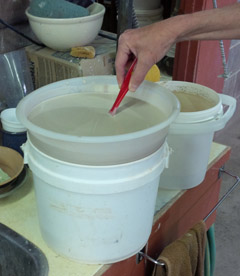Home
Glazes, Engobes
G2934 Cone 6 Matte Base Glaze
G2926B Cone 6 Clear Glossy Base Glaze
GA6-B Alberta Slip Cone 6 Base
L3954B Mid Temperature Engobe
G1916Q Transparent Base Glaze
G1947U Transparent Base - Cone 10R
G2571A MgO Matte Base - Cone 10R
GR10-A Ravenscrag Slip as-a-glaze - Cone 10R
L3954N/J Cone 10 Engobe Base
Glazes and Glaze Recipes - Plainsman
Food Safety
Our base glazes do not contain hazardous ingredients. They are resistant (as bases) to leaching tests in our circumstances. However when you fire them and you add stains, opacifiers, variegators then you are creating something different. Please do your own leaching test.

Before using any of these on a kiln load of ware: Read the documentation. Test first on the clay you intend to use it on. When mixing, screen them to assure a defect-free surface.
About Our Base Glazes
- You can make quality functional surfaces that are resistant to crazing, cutlery marking and leaching.
- If you follow the instructions (about water content, specific gravity and gelling the slurry) they apply without drips, dry quickly, harden to a durable dry layer and do not settle in the bucket.
- Each glaze is well documented, we sell them as powders and you can even get the recipe.
- These are base glazes: use as transparents or add stains and opacifiers (as shown).
- Automatic kilns almost never fire to the correct temperature. It is better to enter programs into your controller manually (based on cones in the kiln adjust the schedule to fire to the correct temperature).
- To avoid surface defects (like blisters) we recommend drop-and-soak manually-programmed firing schedules (approach final temperature at 100F/hr, hold for a short time, drop 100F and soak there (for 30 minutes or more).
Variegating Colored Surfaces
It is usually possible to variegate a colored glaze by adding some rutile or titanium (2-5%). Since the former contains iron, it can muddy lighter colors.
